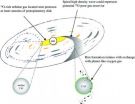(Press-News.org) Johns Hopkins scientists have discovered that PARIS — the protein — facilitates the most common form of Parkinson's disease (PD), which affects about 1 million older Americans. The findings of their study, published March 4 in Cell, could lead to important new targets for treatment.
Previous research has shown that a protein dubbed parkin protects brain cells by "tagging" certain toxic elements for natural destruction. Mutations in the parkin gene cause rare forms of PD that run in families, but its role remained unclear in sporadic late-onset PD, the prevalence of which is increasing as the population ages.
Using genetically alteredn mice as well as human brain tissue, the Hopkins team showed that another protein, PARIS, accumulates when the parkin gene is mutated and its protein degrading ability is blocked. Too much toxic PARIS tamps down the manufacture of a protective protein named PGC-1alpha. The less protection afforded to brain cells by this protein, the more they die and the greater the progression of PD.
"Of all the important changes that lead to the death of brain cells as a result of parkin inactivation, our studies show that PARIS is, without a doubt, a key player," says Ted Dawson, M.D., Ph.D., Leonard and Madlyn Abramson Professor in Neurodegenerative Diseases and scientific director of the Johns Hopkins Institute for Cell Engineering.
To pin down the role of the PARIS protein, the researchers first knocked out the parkin gene in embryonic mice. These animals, despite a 20-percent buildup of PARIS compared with wild-type mice, showed no significant change in the levels of the protective PGC-1alpha, and none of the neurodegeneration that is characteristic of PD, which the researchers measured by counting brain cells. In order to bypass the compensation that they suspected was at play in these young mice (which typically live about 2 years), the team next disabled the parkin gene in 8-week-old (adult) mice. By 10 months of age, these animals with the temporal loss of parkin showed three times the amount of PARIS accumulation in brain cells – similar to the amount in brain tissue from human patients who had mutations in the parkin gene or sporadic PD. Also, PGC-1alpha levels had decreased and a significant loss of neurons – known as neurodegeneration -- had occurred.
"Some might wonder why this same kind of compensation isn't occurring in humans," Dawson says. "Well, it is, but the difference is time. It usually takes us 60 or more years to get the most common form of PD. A body can compensate for only so long and so much. By disabling the gene in the brain cells of adult mice, we accelerated that process and thwarted compensation."
In a further experiment with PARIS, the team created a so-called double knock-out by disabling the gene for PARIS in those same mice in which the gene for parkin already was knocked out. The protective PGC-1alpha levels of these animals — which had no parkin or PARIS — were rescued, and no neurodegeneration occurred. The team then demonstrated that genetically altered mice with an abundance of PGC-1alpha were protected against the same significant loss of neurons.
When the scientists looked at human brain tissue, they also found evidence that PARIS is dependent on parkin function and a chief regulator of the protective PGC-1alpha. By comparing tissue of patients who died with Parkinson's disease with those who died of other causes, they established that when parkin is shut down and PARIS, the "garbage" protein, accumulates, PGC-1alpha levels drop precipitously and neurons die en masse.
"No one has shown that neurons can be rescued by knocking out any of the other elements that parkin tags for destruction," Dawson says. "The fact that we can prevent parkin-associated brain cell death by blocking PARIS gives a promising new drug target that could someday enable us to slow or stop the progression of PD."
With people living longer, more people are developing this common, debilitating neurological disorder, according to Dawson, noting that one in 100 people are afflicted at the age of 60, and four times that many by the age of 80.
INFORMATION:
The study was funded by the National Institutes of Health and the Bachmann Strauss Dystonia and Parkinson Foundation.
Authors of the study, in addition to Ted Dawson, are Joo-Ho Shin, Han Seok Ko, Hochul Kang, Yunjong Lee, Yun-Il Lee, Olga Pletinkova, Juan C. Troconso, and Valina L. Dawson, all of Johns Hopkins.
On the Web:
Ted Dawson: http://neuroscience.jhu.edu/TedDawson.php
Cell: http://www.cell.com/
END
Star-shaped cells in our brains called astrocytes were once considered little more than structures to fill the gaps between all-important neurons. But more recent evidence has emerged to reveal that those astrocytes play more than a supporting role; they are involved in information processing and signal transmission and they help to regulate the shapes of our neurons and their connections to one another.
Now, researchers reporting in the March 4th Cell, a Cell Press publication, have found that astrocytes are also essential for making long-term memories. When they don't ...
Scientists have performed a micro-probe analysis of the core and outer layers of a pea-sized piece of a meteorite some 4.57 billion years old to reconstruct the history of its formation, providing the first evidence that dust particles like this one experienced wildly varying environments during the planet-forming years of our solar system.
The researchers interpret these findings as evidence that dust grains traveled over large distances as the swirling protoplanetary nebula condensed into planets. The single dust grain they studied appears to have formed in the hot ...
If you tend to have trouble picking up the latest dance moves or learning to play a new piano piece, there might be an explanation. A new study published online on March 3rd in Current Biology, a Cell Press publication, shows that people who are fast to learn a simple sequence of finger motions are also those whose brains show large changes in a particular chemical messenger following electrical stimulation.
That chemical messenger, known as GABA, is important for the plasticity of the motor cortex, a brain region involved in planning, control, and execution of voluntary ...
A new study finds that a brain rhythm considered the hallmark of wakefulness not only persists inconspicuously during sleep but also signifies an individual's vulnerability to disturbance by the outside world. In their report in the March 3 PLoS One, the team from the Massachusetts General Hospital (MGH) Division of Sleep Medicine uses computerized EEG signal processing to detect subtle fluctuations in the alpha rhythm during sleep and shows that greater alpha intensity is associated with increased sleep fragility. The findings could lead to more precise approaches to ...
There have been no shortages of horrific natural disasters splashing across headlines in the last year: the devastating earthquakes in Haiti and Chile; the Tsunami in the Philippines; and the volcano eruption in Indonesia--to name just a few. The poly tarps have come to the rescue over and over again in these situations, providing a cheap yet durable material with which to construct a roof or otherwise assist in the process of recovering and rebuilding from natural disaster born tragedy.
In the event of a natural disaster, as people are forced out of their homes or lose ...
How do organs "know" when to stop growing? The answer could be useful in regenerative medicine, and also in cancer – where these "stop growing" signals either aren't issued or aren't heeded. Researchers in the Stem Cell Program at Children's Hospital Boston have now found a regulator of gene activity that tells epidermal stem cells when it's time to grow more skin, as well as a "crowd control" molecule that can sense cell crowding and turn the growth off.
The work, in mice and in human cancer cells, provides clues to new therapeutic strategies for cancer, particularly ...
Not all racial and ethnic groups have equal access to kidney transplantation, according to a study appearing in an upcoming issue of the Journal of the American Society Nephrology (JASN). The results indicate that the reasons for these disparities are varied and that more focused efforts are needed to address them.
For most individuals who develop kidney failure or end-stage renal disease, kidney transplantation is the best treatment option. Unfortunately, certain racial and ethnic groups are less likely to receive kidney transplants than others. Despite the increasing ...
STANFORD, Calif. — Neurons have been derived from the skin of a woman with a genetic form of Parkinson's disease and have been shown to replicate some key features of the condition in a dish, say researchers at the Stanford University School of Medicine. The scientists hope to use the neurons to learn more about the disorder and to test possible treatments. Such a tool is critical because there are no good animal models for Parkinson's disease. It also validates the use of induced pluripotent stem cells, or iPS cells, to model various diseases.
"Now that we can see that ...
STANFORD, Calif. — A short-term treatment with three immune-dampening drugs allowed human embryonic stem cells to survive and thrive in mice, according to researchers at the Stanford University School of Medicine. Without such treatment, the animals' immune systems quickly hunt down and destroy the transplanted cells. The finding is important because it may allow humans to accept transplanted stem cells intended to treat disease or injury without requiring the ongoing use of powerful immunosuppressant medications.
Just as it does with transplanted organs, the human body ...
Plants are able to protect themselves from most bacteria, but some bacteria are able to breach their defences. In research to be published in Science on Friday, scientists have identified the genes used by some strains of the bacterium Pseudomonas to overwhelm defensive natural products produced by plants of the mustard family, or crucifers.
"Microbes only become pathogens when they find a way to infect a host and overwhelm the host defences," said lead author Dr Jun Fan from the John Innes Centre on the Norwich Research Park.
"Our findings answer some important questions ...


